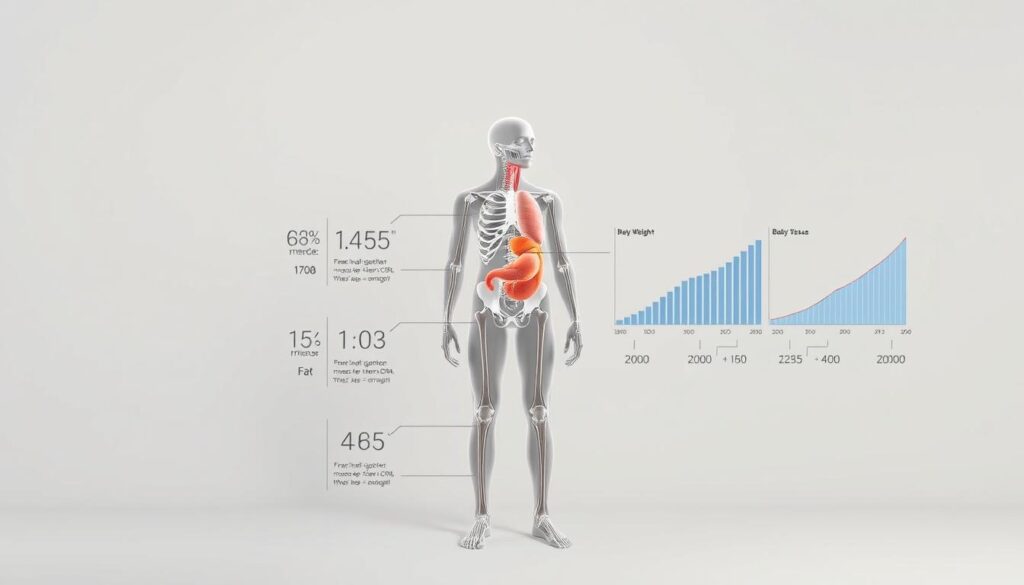How often have you heard that hitting a specific number on the scale guarantees better health? The truth is, personalized metrics matter far more than rigid charts. While tools like BMI offer general guidance, they don’t account for muscle mass, bone density, or genetic factors that shape your unique needs.
Experts agree there’s no universal “ideal” range. Reputable sources like Medical News Today emphasize that formulas such as Devine or Robinson provide estimates, not absolutes. Age, sex, and activity level further refine what’s healthy for you. For example, athletes often weigh more due to muscle while remaining metabolically fit.
This article breaks down four key calculation methods and their pros/cons. You’ll also learn how to combine these insights with BMI and other formulas for a holistic view. By the end, you’ll craft a plan that aligns with your lifestyle—not outdated assumptions.
Key Takeaways
- No single weight range works for everyone—genetics and body composition play critical roles.
- BMI provides a baseline but overlooks muscle mass and metabolic health markers.
- Formulas like Devine and Miller adjust for height but still require personal interpretation.
- Combining multiple tools yields the most actionable insights for health management.
- Focus on sustainable habits rather than chasing arbitrary numerical targets.
Understanding Ideal Body Weight: A How-To Guide Overview
Health assessments often rely on benchmarks, but what defines a target range? Clinicians describe it as a weight range linked to lower risks of chronic conditions. This metric considers factors like bone structure and organ function, not just stature.
What Is Ideal Body Weight?
The term refers to a weight range associated with optimal wellness. Research from Johns Hopkins Medicine highlights its role in predicting cardiovascular and metabolic risks. However, it’s not a fixed number—genetics and lifestyle create variability.
How Height Influences Weight Estimates
Taller individuals typically have higher target ranges due to increased bone and muscle mass. For example, someone at 5’7″ might have a healthy range 20 pounds wider than someone at 5’2″. BMI charts use height-to-weight ratios to categorize ranges:
- Underweight: BMI below 18.5
- Healthy: 18.5–24.9
- Overweight: 25–29.9
These charts offer general guidance but don’t differentiate between muscle and fat. A 2-inch height difference can shift the “healthy” range by 10–15 pounds. Always pair chart data with blood work or body fat analysis for accuracy.
Medical professionals stress personalized evaluations, as formulas like Devine’s only provide starting points. Later sections detail how to combine these tools for actionable insights.
Factors That Influence Your Ideal Weight
Personal health isn’t a one-size-fits-all equation, especially when determining your optimal range. Biological variables like muscle development and hormonal changes create significant differences in what qualifies as a healthy weight. Let’s explore how these elements interact.

The Role of Age, Sex, and Muscle Mass
Metabolism slows by 3–8% per decade after 30, according to Mayo Clinic studies. This means caloric needs decrease, even if activity levels stay consistent. Sex also plays a role—men often carry more muscle mass, leading to higher weight range estimates compared to women of the same height.
Impact of BMI, WHR, and Body Composition
While body mass index (BMI) calculates height-to-weight ratios, it can misclassify muscular individuals as overweight. Waist-to-hip ratio (WHR) adds nuance by measuring fat distribution. Research shows WHR values above 0.9 (men) or 0.85 (women) correlate with higher cardiovascular risks.
| Factor | Effect on Weight Estimates | Tool to Assess |
|---|---|---|
| Muscle Mass | Increases total pounds without health risks | Body fat calipers |
| Age | Reduces metabolic rate by 100–150 calories/day | BMR calculators |
| Sex | Men: +10–15 lbs vs. women at same height | DEXA scans |
“A 2023 Johns Hopkins study found individuals with identical BMIs had up to 40% differences in body fat percentage—proof that single metrics can’t determine ideal health status.”
Combining tools like personalized health assessments with professional guidance provides the clearest picture. For instance, athletes might fall outside standard BMI categories yet maintain excellent metabolic markers.
Determining Your ideal body weight for height: Formulas and Tools
Numerous equations claim to pinpoint your optimal physique, but which ones hold scientific merit? Clinicians rely on validated formulas to estimate healthy ranges, though results vary by method. Understanding these differences helps you interpret data from calculators and charts effectively.

Comparing Common Formulas
The Devine formula remains the gold standard, adjusting for height in inches over 5 feet. For men: 50 kg + 2.3 kg per inch. Women: 45.5 kg + 2.3 kg per inch. Robinson’s method uses similar math but starts with 52 kg (men) or 49 kg (women).
Miller’s approach reduces the per-inch multiplier to 1.9 kg, while Hamwi adds 6 pounds per inch for men. Lorentz factors in sex but not frame size. A 5’7″ woman might see a 10-pound spread across these methods—proof that context matters.
Leveraging Online Calculators and Tools
Modern calculators simplify these equations. Reputable tools auto-save height and sex inputs, allowing metric/imperial toggles. Enter your details once, and compare outputs from Devine, Robinson, and others side-by-side.
Always pair results with BMI and muscle mass data. A 180-pound athlete could show “overweight” on charts but have 12% body fat. As one sports physician notes: “Equations guide—they don’t dictate. Labs and lifestyle complete the story.”
Using Height-Weight Charts and BMI for Accurate Insights
Health professionals often combine charts and formulas to assess wellness trends. These tools help identify potential risks but require careful interpretation to avoid oversimplification.

Deciphering BMI Categories and Their Limitations
The CDC defines BMI ranges as follows:
| Category | BMI Range | Weight Example (5’9″) |
|---|---|---|
| Underweight | <18.5 | <125 lbs |
| Healthy | 18.5–24.9 | 125–168 lbs |
| Overweight | 25–29.9 | 169–202 lbs |
| Obesity | 30+ | 203+ lbs |
These measurements don’t distinguish muscle from fat. A 180-pound athlete and sedentary person could share the same BMI but face vastly different health factors.
Interpreting Weight Charts for Different Heights
Height-weight charts show wider ranges for taller individuals. For example, NIH data suggests:
- 5’4″: 110–144 lbs (healthy range)
- 6’0″: 140–183 lbs (healthy range)
Always pair chart data with blood pressure readings or body fat measurements. As one nutritionist notes: “Numbers tell part of the story—energy levels and lab results complete it.”
While these tools provide quick references, they work best alongside professional evaluations. A 15-pound variance might signal concern for one person but reflect natural muscle growth in another.
Practical Tips for Achieving a Healthy Ideal Weight
Building sustainable habits beats short-term diets for long-term wellness. Adults often face conflicting advice, but studies show combining smart nutrition, regular movement, and progress tracking delivers lasting results. Start with these evidence-backed strategies to align your routine with health goals.
Nutrition, Exercise, and Lifestyle Strategies
Prioritize whole foods over processed options. The balanced nutrition guidelines suggest filling half your plate with vegetables and lean proteins. For example, swapping sugary snacks for nuts or Greek yogurt can curb cravings while fueling muscle growth.
Incorporate strength training twice weekly. Research shows adults who lift weights maintain metabolic health better than those focusing solely on cardio. Pair this with 150 minutes of moderate activity like brisk walking—small bursts throughout the day count!
- Track meals using apps like MyFitnessPal to spot patterns
- Sleep 7–9 hours nightly; poor rest disrupts hunger hormones
- Hydrate before meals to reduce overeating
Integrating Expert Health Advice and Monitoring Tools
Doctors stress personalized plans over generic rules. “A 10-pound loss might transform one person’s health metrics but leave another’s unchanged,” notes a Johns Hopkins physician. Schedule check-ins to review blood work or body composition scans.
Use online calculators to track trends, not daily fluctuations. For example, inputting weekly measurements into a progress index reveals if changes align with goals. Challenges like time constraints? Batch-cook meals or try 15-minute HIIT sessions.
“Consistency matters more than perfection. Adjust strategies every 3–4 weeks based on results.” – Registered Dietitian, Mayo Clinic
Finally, celebrate non-scale wins: better energy, looser clothes, or improved lab numbers. These markers often matter more than any single digit.
Conclusion
Navigating health metrics requires more than just numbers—it demands context. While formulas like Devine or Robinson offer starting points, individual conditions such as muscle mass and age shape what’s realistic. Charts and calculations provide frameworks, but they’re tools, not rules.
Practical management hinges on pairing these insights with action. Nutrition adjustments, consistent movement, and progress tracking often yield better results than fixating on a single number. Research from recent studies highlights how body composition varies widely even among those with identical weights.
Always consult healthcare providers to account for unique factors like hormonal changes or bone density. A lot depends on lifestyle habits and genetic predispositions—elements no chart can fully capture.
Use this guide as a foundation, not a final answer. Combine multiple methods, verify findings with professionals, and prioritize sustainable choices over rigid targets. Health isn’t a formula—it’s a personalized journey.

